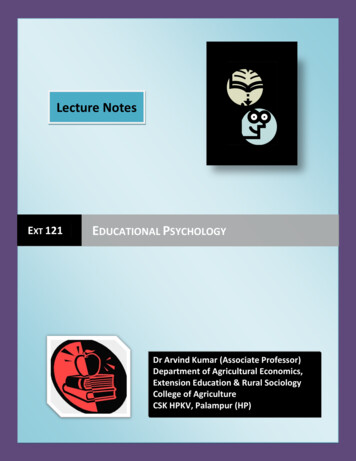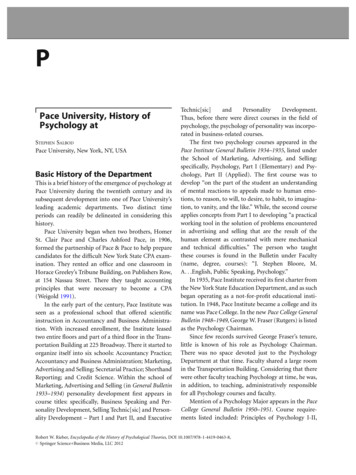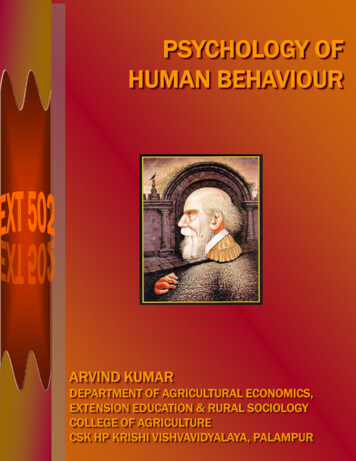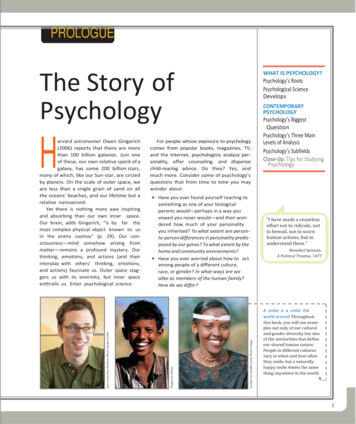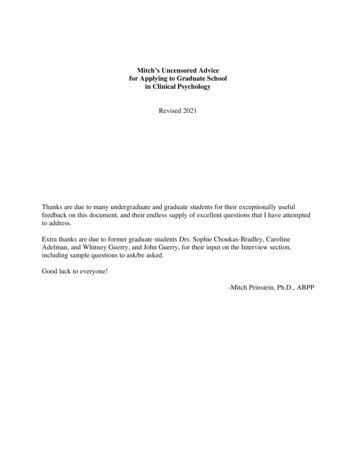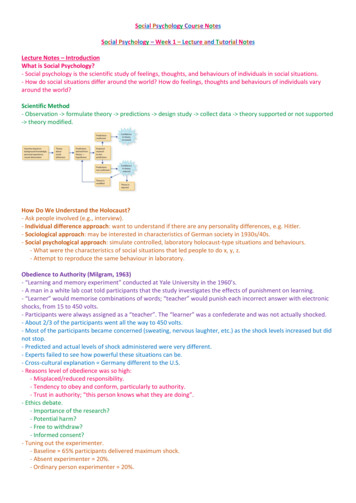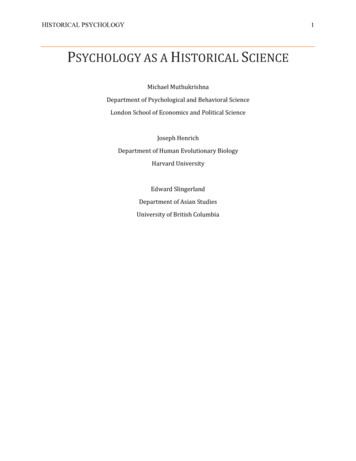
Transcription
HISTORICAL PSYCHOLOGY1PSYCHOLOGY AS A HISTORICAL SCIENCEMichael MuthukrishnaDepartment of Psychological and Behavioral ScienceLondon School of Economics and Political ScienceJoseph HenrichDepartment of Human Evolutionary BiologyHarvard UniversityEdward SlingerlandDepartment of Asian StudiesUniversity of British Columbia
HISTORICAL PSYCHOLOGY2AbstractPsychology has traditionally seen itself as the science of universal human cognition, and has onlyrecently begun seriously grappling with the issue of cross-cultural variation. Here we argue that theroots of cross-cultural variation often lie in the past. Therefore, to understand not just the way, butalso why psychology varies, we also need to grapple with cross-temporal variation. Psychologyneeds to become a historical science. The traces of past human cognition accessible throughhistorical texts and artifacts can also serve as a valuable, and yet currently almost completelyunutilized, source of psychological data. This data from dead minds opens up a new and untapped,highly diverse subject pool. The cohort effects we measure are a sliver of the temporal variation weshould expect over history. We review examples of research that may be classified as historicalpsychology, introduce sources of data and methods for analyzing historical data, explain for thecritical role of theory, and discuss the variety of ways in which psychologists can add historicaldepth and nuance to their work. Historical psychology is a critical next step toward becoming agenuinely universal science.Keywords: cultural evolution, cultural psychology, culture, historical databases, large-scale textualanalysis, science-humanities integrationIntroductionOur psychology is shaped by our societies (Henrich 2016; Henrich et al. 2010b) and our societiesare shaped by their history. Humans living in different societies across the world vary in multipleways, from normative behaviors about how and to whom we should be prosocial (Henrich et al.2001, 2010a; Muthukrishna et al. 2020; Santos et al. 2017) to the ways that our brains processvisual information (Dehaene et al. 2010; Han et al. 2013). Understanding present-day psychologyrequires understanding the past processes, environments, and constraints that led to thatpsychology. Thus, for psychology to develop a full theoretical understanding of human behavior(Muthukrishna & Henrich 2019), psychology needs to also be a historical science.Cultural evolution offers a theoretical framework for explaining cross-cultural psychologicaldifferences (Boyd 2018; Boyd & Richerson 1985; Chudek et al. 2015; Henrich 2016; Muthukrishna& Henrich 2019). Part of our psychology includes a suite of social learning strategies (reviewed inKendal et al. 2018) that allow us to acquire adaptive beliefs and behaviors by selectivelyoverimitating (Hoehl et al. 2019), for example, successful people, those whom others copy(prestige), or the majority or plurality (conformist bias). Through these selective social learningprocesses, we acquire many aspects of psychology, such as norms of what constitutes fairness(Blake et al. 2015), overprecision in confidence (Moore et al. 2018; Muthukrishna et al. 2018), andthe tendency to discount the future (Amir et al. 2019). Some of this acquired psychology overridesgenetic tendencies. Chili peppers, for instance, induce pain in mammals as a deterrent to beingconsumed, but in regions where people stand to benefit from the antimicrobial properties ofcapsaicin, cultural training causes them to interpret this pain as pleasure (Billing & Sherman 1998;Tewksbury & Nabhan 2001).
HISTORICAL PSYCHOLOGY3This selective retention of successful beliefs, behaviors, norms, institutions, skills, and technologyallows cultures to evolve solutions to problems that are beyond the comprehension of any singleperson. We need not understand the causal mechanism of a particular belief or behavior to practiceit (Derex et al. 2013, 2019; Muthukrishna et al. 2013; Muthukrishna & Henrich 2016)—spiceconsuming societies do not enjoy spiciness because of their understanding of the interactionbetween spice and health. Indeed, we typically have a shallow understanding of the beliefs,behaviors, and technologies we possess, despite overestimating our true level of understanding(illusion of explanatory depth; Rozenblit & Keil 2002; Sloman & Fernbach 2017). Just as geneticevolution has led to physiology that no genetic engineer could design, cultural evolution has led tonorms, practices, technologies, and institutions that not even the brightest among us could recreate(Henrich 2016; Muthukrishna & Henrich 2016).Cultural evolutionary theory describes the processes by which important aspects of humanpsychology evolve and persist as adaptations to environments over time. Thus, cultural evolutionoffers not only a theoretical framework for explaining cross-cultural psychological differences, butalso cross-temporal psychological differences. Important aspects of present-day psychology lie inthe past—either the past environments of present-day societies or the past environments ofmigrants who live in these present-day societies. These beliefs and behaviors may persist even afterthe environment changes or after the group moves to a new environment (De Leersnyder et al.2011; Dinesen 2012; Giavazzi et al. 2014; Mesoudi et al. 2016; Norris & Inglehart 2012).Innovations, of course, occur in each new generation, but innovation too, is built on the existingcultural repertoire accumulated over many previous generations (Muthukrishna & Henrich 2016).Historical path dependence (Page 2006) can constrain our technology and institutions, particularlyin the absence of sufficiently strong countervailing selection pressures. We use QWERTY keyboardstoday not because they are efficient, but because they needed to be inefficient on early typewritersto avoid keys jamming. If the US Constitution were written today, it would look very different(Rockmore et al. 2018). Consider the many challenges to switching to the more efficient Dvorakkeyboard layout or amending the US constitution.Path dependence also affects our psychology. For example, industrialization may have increasedboth our color terms and our ability to distinguish and recall different shades (Gibson et al. 2017).The speed at which WEIRD children master their color terms has increased just within the last halfcentury (Pitchford & Mullen 2002). Less materially secure environments develop norms againstdeviation, because the potential cost of deviating from the current accumulated adaptive norms canbe high, often threatening the group welfare (Hruschka et al. 2014; Hruschka & Henrich 2013;Jackson et al. 2019; Muthukrishna & Henrich 2016). Norms against deviation, often referred to ascultural tightness, are a particularly interesting example, because they affect the rate of culturalinnovation itself; tighter societies produce more incremental rather than revolutionary inventions(Chua et al. 2019; Gelfand 2018; Muthukrishna & Henrich 2016). Societies more resistant to changemay also be more constrained by existing practices, though this same conformist, norm-adheringpsychology, may also make them more vulnerable to abrupt society-wide shifts (Muthukrishna &Schaller 2019).At any given time, cultural evolution is constrained by what’s known as the adjacent possible(Muthukrishna & Henrich 2016). To see this, consider an analogy in genetic evolution (Chatterjeeet al. 2014; Kauffman 2003): an organism is constrained by its current genome. New mutations
HISTORICAL PSYCHOLOGY4need to fit with the current complex interaction of genes that produce the organism. Humanpopulations have optimized levels of skin-darkening melanin to match levels of UV radiation thatvary with latitude: skin light enough to synthesize sufficient Vitamin D, but dark enough to avoidskin cancer (Jablonski 2018; Jablonski & Chaplin 2010). But no human population could evolvewings in any reasonable timeframe. Within cultural evolution, we see similar constraints on howcountries select new industries in which to invest (Hidalgo et al. 2007) and how cultural andpsychological innovations emerge (Muthukrishna & Henrich 2016). These tend to be incrementalchanges, serendipitous discoveries, or recombinations of existing practices. Of course, unlike genesin complex organisms, culture can be recombined and transmitted horizontally, allowing forinnovations in one place to spread to another through processes of cultural-group selection, such asmigration, relative population growth, conflict, and prestige-biased group-level transmission(Henrich 2016; Henrich & Muthukrishna 2020; Richerson et al. 2016). The spread of monogamousmarriage offers a historical example. Approximately 85% of human societies in the anthropologicalrecord have permitted polygynous marriage and evolutionary models suggest that large wealthinequality should favor polygyny, but monogamous marriage spread rapidly with religion, inparticular, Christianity (Henrich et al. 2012). Although polygyny may be more economicallyefficient under conditions of large wealth inequality (polygyny threshold model; Orians 1969;Verner & Willson 1966), monogamy can create more stable, safe societies by resolving the problemof young men without sufficient resources to marry and reproduce (Henrich et al. 2012). Historysuggests that while we might think that cultural evolution can be driven by radically new ideasgenerated by the powerful rationality and creativity of our big brains, in reality each of us is stuckthinking with the mental tools, heuristics, beliefs, expectations and worldviews bequeathed to us byearlier generations.Thus, our psychology is shaped by millions of years of genetic evolution, thousands of years ofcultural evolution, and a short lifetime of experience. When most animals encounter a newenvironment, they are forced to genetically adapt. Our species has some local genetic adaptations(for review, see: Fan et al. 2016; e.g. adaptation to UV radiation, Jablonski & Chaplin 2017; malaria,Kwiatkowski 2005; altitude, Yi et al. 2010), but most differences we see around the world arecultural rather than genetic (Bell et al. 2009). To develop better theories of human behavior(Muthukrishna & Henrich 2019) requires moving beyond cataloguing cross-cultural differences andtoward understanding where they come from and how they change. The WEIRD people problem isnot just a matter of geography, but of history (Henrich et al. 2010b; Nisbett 2003).Societies in the past can be as culturally distant as societies in another place. The same argumentfor geographical variation in psychology also applies to temporal variation. What we measure ascohort effects are a sliver of the cross-temporal variation we would expect in a culturally evolvingspecies. History serves as a kind of psychological fossil record, which opens up an exciting, andhitherto mostly untouched, source of “data from dead minds” (Martin 2014). Patterns of pastcognition are captured in historical artifacts, ranging from archeological remains to written texts,that are not only important for understanding the roots of modern psychological patterns, but alsorepresent an important source of less-WEIRD data (Slingerland 2014, 2015). Although our inabilityto experimentally manipulate or directly observe historical participants places limits on what wecan learn from this data, traces of human thought can be a rich and informative source ofdescriptive information on past cognition, both explicit and implicit.
HISTORICAL PSYCHOLOGY5With few exceptions, psychology has largely ignored history and historical data, perhaps in part dueto its lack of focus on building cumulative theories to explain human behavior (Muthukrishna &Henrich 2019). But just as economic history helps us understand present-day economics (Nunn2009), historical psychology can help us understand the psychology of the past, which is crucial tounderstanding the psychology of the present and its many cross-cultural differences. Here we will(1) review work that might be classified as historical psychology; (2) introduce some methods thatmay be useful to historical psychologists, including how to extract data from dead minds; (3)explore the role of theory in mapping history to psychology; and (4) provide some conclusionsconcerning the future of this emerging field.Historical Psychology TodayTo explain contemporary behavior and psychology, an increasing number of researchers havefound themselves turning to cultural evolutionary theories and historical data. Here, we describesome illustrative examples that link contemporary psychological variation—including cooperation,trust, personality and gender differences—to historical processes focused on religion, kinship,formal institutions (democracy), economic patterns and ecological factors.Religious evolution and social psychologyWhat, if anything, is the connection between religion and social motivations? This question hasfrequently been asked within psychology, but few efforts to tackle it have brought a clearlyarticulated theory, an appreciation for how and why religions have changed over millennia, or arecognition of the extent of global religious diversity. Indeed, “religion” in psychology has oftenmeant Christianity, though most people in the world are not Christians and Christianity is, over thescale of world history, a relatively recent development.Addressing these issues within a historical and cultural evolutionary framework (Atran & Henrich2010; Norenzayan et al. 2016), a recent approach proposes that the supernatural beliefs and ritualpractices of contemporary religions have been shaped by intergroup competition over millennia (aswell as by our evolved psychology) in ways that favor their success in competition against otherreligions. The argument proposes that this intergroup competition may have favored supernaturalagents (e.g. deities) and/or cosmic forces (e.g. karma) along with prescribed beliefs and behaviorsthat promote more intensive cooperation within a broader social sphere. The resultingpsychological shifts permitted societies to scale up in size and complexity and/or remain stable forlonger. Particular religions therefore may have provided a kind of social technology for scaling upfrom the relatively small-scale hunter-gatherer populations of the Paleolithic to modern-nationstates with millions or even billions of people. In some traditions, the gods became increasinglymorally concerned about precisely those areas of life in which people struggle to cooperate withstrangers or suppress their inclinations to exploit others through theft, murder, dishonesty andadultery (Wright 2009). These supernatural police became increasingly equipped with the powerto monitor and punish violators of new universal codes of morality (McNeil 1991). Some deitieseven gained the ability to see into people’s hearts and control their fate in an afterlife, whichbecame contingent on their compliance with divine decrees. In many large-scale societies, thesegods gradually acquired the traits of omniscience, omnipotence, and omnibenevolence, co-evolvingwith the scale of their societies.
HISTORICAL PSYCHOLOGY6To test this historical theory, researchers have taken a variety of approaches. The first approachinvolves taking advantage of the contemporary diversity in religious beliefs to see if, indeed, thosewho believe more strongly in powerful moralizing gods are relatively more prosocial or fairminded toward socially or even physically distant co-religionists. That is, can a religious groupserve as a super-ethnic identity for cooperation? This research involved an interdisciplinary teamof psychologists, anthropologists, and religious studies scholars who conducted two waves ofethnographic and experimental research in 15 diverse populations around the globe (Lang et al.2019a; Purzycki et al. 2016, 2018a). Their sample of hunter-gatherers, pastoralists, horticulturalistsand wage laborers belonged to a diversity of religious traditions, including Buddhism, Christianity,and Hinduism, as well as local traditions that incorporate ancestor worship and animism. Based ona preliminary interview, the researchers selected two local deities in each population: (1) the mostpowerful moralizing god (e.g. Yahweh, Shiva, etc.) entertained by the population and (2) a salient,but less powerful supernatural being (e.g. an ancestor god or forest spirit). In subsequentinterviews, the researchers assessed participants’ beliefs about the monitoring, punishing andrewarding powers and inclinations of these gods, including their influence over the afterlife. Finally,to assess people’s prosocial inclinations (as specified by the theory), the team administered twodifferent one-shot experimental games involving an anonymous stranger: The Dictator and RandomAllocation Games (RAG). In the Dictator Game, a “dictator” is given a sum of money, which they candivide as they wish between themselves and a recipient. In the RAG, a sum of money is also dividedbetween the participant and a recipient, but the allocation should be random, such as based on rollsof a die; the outcomes of these rolls is only known to the participant, offering an opportunity forcheating. To test the effects of religious identity, these tasks were modified: participants were askedto make two monetary allocations, one between a co-religionist in a distant town and themselves(Self-game) and a second between another distant co-religionist and a local co-religionist from theparticipant’s home community (Local co-religionist game). In the Dictator Game, participantssimply decided how much money to put in each cup (each assigned to one of the recipients). In theRAG, participants rolled a six-sided die and had to allocate either to their preferred cup or the othercup. This die roll concealed each allocation decision from the researchers, but not from anomniscient god. The researchers did not have omniscience but did have probability and statistics,which allowed them to estimate biases in people’s allocations.The results from both experimental tasks demonstrate that those who believe more strongly in amoralizing, punishing god allocated the game money more equitably toward the distant coreligionist in both the Dictator and Random Allocation Games. Using the data from the RAG, Figure1 shows some of the major findings. For both the Self and Local co-religionist games, the squaresand circles give the odds ratios for six key variables in a multi-level binary logistic regression. Thestronger were people’s beliefs in the punishing and monitoring powers of their moralizing god, themore equally they allocated towards the distant co-religionist. This suggests that some kinds ofdeities can expand the moral circle. Notably, these analyses only compare individuals within eachpopulation, so site-level differences like national GDP, climate, ecology, etc. cannot explain thesepatterns. The researchers also controlled for the participants’ age, sex, number of children (Figure1), household size, material insecurity (Figure 1) and emotional closeness to the recipient.Interestingly, only beliefs about the punishing and monitoring capacities of the big, moralizing godmattered; beliefs about the weaker, less moralizing supernatural agents did not account forsignificant behavioral variation. This follows directly from the theory since most “small gods” areeither not particularly morally concerned or only locally concerned with the behavior of other clan
HISTORICAL PSYCHOLOGY7or community members (Hadnes & Schumacher 2012; McNamara & Henrich 2018; Norenzayan etal. 2016).FIGURE 1. EFFECTS OF DIVINE PUNISHMENT AND MONITORING ON ALLOCATIONS TO DISTANT CO-RELIGIONISTS IN THERANDOM ALLOCATION GAME FOR BOTH THE SELF AND LOCAL CO-RELIGIONIST GAMES. THESE ODDS RATIOS ARE DERIVEDFROM A MULTI-LEVEL BINARY LOGISTIC REGRESSION IN WHICH THE ALLOCATION OF EACH COIN TO ONE OF THE TWO CUPS ISREGRESSED ON A BATTERY OF PREDICTORS. THE MODELS INCLUDE FIXED EFFECTS FOR EACH POPULATION AND, AT THEINDIVIDUAL LEVEL, CONTROLS FOR AGE, SEX, NUMBER OF CHILDREN, HOUSEHOLD SIZE, MATERIAL INSECURITY ANDEMOTIONAL CLOSENESS TO THE RECIPIENT. ADAPTED FROM PURZYCKI ET AL. (2016). PLOTS AVAILABLE UNDER CC BY4.0 AT : Researchers have proposed that moralizing religions arose in response to evoked psychologicalrecalibrations created by rising security over historical time, especially due to greater food security among elites(Baumard & Chevallier 2015; Baumard et al. 2015). With their changed psychology, elites revised religiousdoctrines and formulated moralizing gods concerned with cooperation and sex. Unfortunately, efforts to testthis hypothesis using detailed data on people’s material security, morality and supernatural beliefs have not yetprovided support (Banerjee & Bloom 2015; Purzycki et al. 2018b).Notably, in testing this theory, Lang et al. (2019a) did not find the sharp border their theorypredicts in how people should treat distant co-religionists vs. people from other religions; however,the particular contexts used in this study created a number of methodological challenges forproperly testing this prediction. In some sites, for example, religion was highly correlated withethnicity, and in some cases divisions between the ingroup and outgroup were not clear cut(Protestants in different denominations; Protestants vs Catholics; Christians vs Muslims or Hindus).This cross-cultural work dovetails with a large body of laboratory experiments testing whetherreligious primes influence prosociality: dozens of studies reveal how unconsciously reminding
HISTORICAL PSYCHOLOGY8believers (but not non-believers; Shariff et al. 2016)of their moralizing gods or supernatural forces(karma) can increase fairness in dictator games, cooperation in prisoner’s dilemmas and honesty ina variety of tasks (Shariff et al. 2016; White et al. 2019). Although most work has focused onpriming Christians, the literature has gradually expanded to reveal parallel effects among Muslims,Hindus and Buddhists (Aveyard 2014; Duhaime 2015; Rand et al. 2014; Xygalatas 2013; Yilmaz &Bahçekapili 2016).Turning to the historical dimension, other historical and anthropological data suggest that powerfulgods, contingent afterlives, universal moral codes, and divinely infused notions of free-will onlygradually arose and spread as societies scaled up in size and complexity (Atran & Henrich 2010;Henrich forthcoming; Norenzayan et al. 2016). To test this claim, psychologists and theircollaborators have analyzed a global anthropological database of over 1200 different societies. Theresults confirm that the presence of moralizing gods is unambiguously associated with measures ofsociopolitical complexity (Botero et al. 2014). Similarly, using a database of ethnographicobservations from Oceania at the time of European contact (Watts et al. 2015b), researchers haveapplied phylogenetic techniques for the historical reconstruction of cultural history to examine thecoevolution of societal political complexity and the presence of moralizing gods who usesupernatural punishment. These analyses suggest that notions of broad supernatural punishmentlikely facilitated increases in political complexity and scale of societies (Watts et al. 2015a).Despite some fascinating findings, the major shortcoming of this research program is a lack ofsystematic, historical and longitudinal data on either religion or psychology. As we will discussbelow, the advent of large-scale, coded historical databases, such as the Database of ReligiousHistory (DRH; Slingerland & Sullivan 2017) or the Seshat Databank (seshatdatabank.info; Francoiset al. 2016), will allow future studies to incorporate historical data in a much more rigorous andcomprehensive manner.The historical origins of WEIRD psychologyDuring late antiquity the branch of Christianity that evolved into the Roman Catholic Church begandeveloping a package of prohibitions and prescriptions surrounding marriage and the family. TheChurch banned polygamy, cousin marriage, levirate marriage, and arranged marriage whilepromoting testamentary inheritance and individual land ownership (not family ownership). Thebans on marrying relatives began with first cousins (and closer) but eventually expanded to includesixth cousins; the forbidden circle prohibited not only all blood relatives, but also all affines andspiritual kinfolk (e.g. god daughters). As the Church diffused across Europe over the nextmillennium, the imposition of these policies dramatically altered the social organization ofindigenous Europeans, breaking them down into monogamous nuclear families while at the sametime dissolving tribal distinctions. Consequently, centuries before industrialization and evenEurope’s global expansion, the populations of Latin Christendom came to possess a virtually uniqueform of social organization, one not built primarily on kinship (Goody 1983; Mitterauer & Chapple2010).In light of these historical findings, researchers have proposed that the medieval Catholic Church,particularly through the Church’s impact on kinship organizations, can explain a substantial swathof contemporary psychological variation, along dimensions such as individualism, tightness,
HISTORICAL PSYCHOLOGY9conformity, independence, moral judgment and impersonal prosociality, which includescooperation, trust and fairness toward strangers and anonymous others as well as third-partypunishment (Henrich forthcoming; Schulz et al. 2019). To test these hypotheses derived from thistheory, they assembled historical, anthropological and psychological databases. By tracking thehistorical diffusion of bishoprics across Europe, Schulz et. al. calculated the duration of exposure tothe Church from roughly 500 to 1500 CE and used this to predict contemporary psychologicalvariation within Europe on four psychological measures: individualism-independence, conformityobedience and both impersonal fairness and trust. As expected, Europeans from populations withmore centuries under the Church are now more individualistic and independent, less inclinedtoward conformity and obedience, and show greater trust and fairness towards strangers. Theseresults only compare individuals living in the same country and hold constant a vast array ofcontrol variables, including individual religiosity, religious denomination, income and education, aswell as regional variables including historical prosperity, latitude, agricultural potential, pathogenstress and terrain ruggedness.This research also reveals links between kinship intensity and both medieval Church exposure andcontemporary psychological variation. Within Europe, detailed analyses show that the morecenturies a local population had under the Church, the lower the rate of cousin marriage in the 20thcentury. They also demonstrate that less cousin marriage is associated with less conformity andobedience, less individualism and independence, and reduced level of impersonal trust andfairness.SIDE BAR: Some researchers have sought to explain contemporary psychological variation as a consequence ofdifferences in wealth or material security, arguing in part that the experience of more secure or abundantenvironments during early childhood evokes life-long psychological calibrations (Frankenhuis et al. 2016; Nettle2010). While some evidence supports this view (Baumard 2017), the impact of Church exposure and kinshipintensity on psychology shown here are independent of individual-level measures of income, wealth andeducation measures, regional level measures of historical prosperity and national wealth.Extending this analysis globally using 17 different psychological measures, Schulz et al. (2019) alsoshow that national populations that have experienced more centuries under the Church are moreindividualistic (Figure 2a), analytic in their thinking (Figure 2b), and impersonal in theirprosociality towards strangers, including greater impartiality (in experiments and observationaldata), higher public goods contributions (in experiments and blood donations), and more trust inout-groups, (relative to in-groups, Figure 2c). They also show less conformity (Asch task andsurveys; Asch 1956; Bond & Smith 1996)(Asch task and surveys; Asch 1956; Bond & Smith 1996),greater tightness (Gelfand et al. 2006), more embeddedness (Schwartz 2006), stronger obedience(based on the World Values Survey), and less nepotism (Figure 2d). These results are furtherconfirmed by comparing second-generation immigrants living in the same European countries, butwho traced descent back to populations scattered around the globe. Studies by other researchersconfirm the key relationship between kinship intensity and the predicted psychological outcomes(Akbari et al. 2019; Enke 2019).
HISTORICAL PSYCHOLOGY10FIGURE 2. THE CROSS-NATIONAL RELATIONSHIPS BETWEEN CHURCH EXPOSURE, MEASURED AS YEARS UNDER THEWESTERN CHURCH, AND FOUR DIFFERENT PSYCHOLOGICAL OUTCOMES: (A) HOFSTEDE’S INDIVIDUALISM MEASURE, (B)ANALYTIC THINKING (ASSESSED USING TRIADS), (C) OUT-GROUP VS. IN-GROUP TRUST (BASED ON 6 WORLD VALUES SURVEYQUESTIONS) AND (D) NEPOTISM (BASED ON INTERVIEWS OF EXECUTIVES AT WORLD ECONOMIC FORUM ON HIRINGRELATIVES). ADAPTED FROM SCHULTZ ET AL. (2019). PLOTS AVAILABLE UNDER CC BY 4.0 ssful democratic institutionsInstitutions rest on invisible cultural and psychological pillars. For example, a constitution’sproclamations are irrelevant without a belief in the rule of law or norms of punishment forviolations of this rule; markets require traders to trust one another; and cooperation at the scale of
HISTORICAL PSYCHOLOGY11family and friends can corrupt impartiality (Muthukrishna 2017; Muthukrishna et al. 2017).Institutions coevolve with their underlying psychological foundations, which can maketransplantin
Historical psychology is a critical next step toward becoming a genuinely universal science. Keywords: cultural evolution, cultural psychology, culture, historical databases, large-scale textual analysis, science-humanities integration Introduction Our psychology is shaped by our societies (Henrich 2016;


